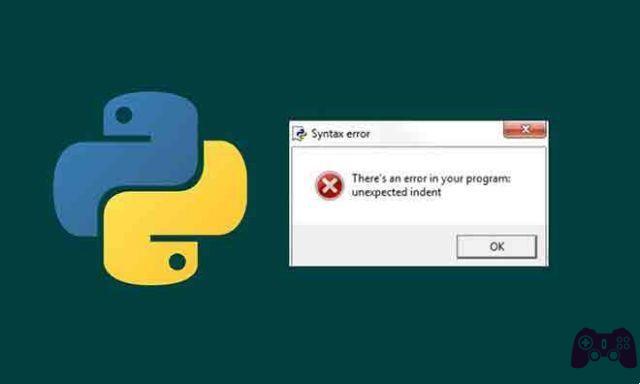
In this tutorial, we will show you the steps to fix the indent error in Python. In programming languages, an indent is a set of spaces before the start of a line to indicate that it is the beginning of a new paragraph.
It is mainly used in the case of “For”, “If” and other related loops, thus giving it a structured perspective and allowing the interpreter to execute the code. However, if you end up losing these whitespace, it could be causing problems.
How to fix indentation error in Python
Likewise, if the number of spaces is not evenly distributed, it could also contribute to the error. In this regard, Python follows the PEP8 whitespace rule, so it is generally recommended to have four whitespace and no tab characters.
But if you don't follow these rules, you could get stuck with re-entry issues. If that happens, you might want to take the help of this guide to fix the indentation error in Python. Follow for full instructions.
- How to fix ShadowPlay not recording audio
Why an indentation error occurs
As mentioned in the introductory paragraph, one of the main reasons for the indentation error is the absence of tabs and / or whitespace between lines of code. Since python uses procedural language, if you miss adding tabs or spaces between lines of code, you will most likely encounter this error. Although in some cases the whole program will run fine, in others the error will come in the middle of execution and thus stop the whole process.
Mentioned below are some of the common causes of an indentation error in Python:
- While encoding you are using both the card and the space. Although in theory they both serve the same purpose, when used alternately in a code, the interpreter gets confused as to which alteration to use and thus returns an error.
- While programming, you entered an indent in the wrong place. Since python follows strict guidelines when it comes to organizing your code, if you put an indentation in the wrong place, the indentation error is mostly inevitable.
- Sometimes during the conclusion of a long program, we tend to miss the indentation of compound declarations like for, while and if and this in most cases will lead to an indentation error.
- Last but not least, if you forget to use user defined classes, you will most likely get an indent error.
Solution no. 1
While there is no quick fix to this problem, one thing you need to keep in mind as you try to find a solution for the indent error is the fact that you have to go through each line individually and find out which one contains the error.
In Python, all lines of code are arranged in blocks, so it becomes easier to spot an error. For example, if you used the if statement on any line, the next line must definitely have an indent.
Solution no. 2
If the above-mentioned solution didn't work for you and you are having a hard time figuring out which line you missed the indent on, follow these steps. Go to your code editor settings and enable the option that shows the card and white spaces . Once this feature is activated, you will see small single dots between the code, where each dot represents white space or a tab. If you see that a period is missing somewhere it needs to be, then that line probably has the indent error.
Another option to get out of this problem is to use the indentation guide built into the Python interpreter.
Enabling this option will walk you through each line of code and show you exactly where your error is. While this method is highly inefficient taking into account that the program contains several lines of code, this is the safest way to find and fix all existing errors.
While distributing spaces, some people generally confuse the space bar and the Tab key. Although both can be used for this purpose, but in Python, you have to select one and keep it. If you use both interchangeably, the interpreter may not be able to distinguish whitespace. Also, if you're using For, If, and other similar loops, make sure you're following the correct indent patterns.
While using these nested loops, uneven indentation seems to be the main reason for the error. See the example above for reference. The first block has the second block which in turn contains the third block. After this, we continue the second block and then the first. You are able to distinguish between all of these because there is an equal indentation between these nested blocks. So always follow this rule as you indent these loops.
How to fix indentation error in Python
To begin with, whenever dealing with For and If blocks, follow the correct indent pattern with equal spacing. And if you're using Tab for whitespace, just continue with that, don't mix it with the space bar.
For example, in the image below, look at how we nested the If block inside the For and then finished both loops. You should also follow a similar pattern and this should fix the indentation error in Python.

Along the same lines, your code editor may have the ability to view all tabs and whitespace. It is recommended to enable it before proceeding with the encoding. For example, if you are using Notepad ++, go to the View tab and go to the Show Symbol option. Then select the Show whitespace and TAB option.

Now, by enabling this function, single points will be placed for each space. This will give you an idea of the number of whitespace you have inserted before each line.
In the screenshot below, the red sections indicate three spaces with three single dots, while the green has four single dots (four spaces). This will help you indent each block clearly and thus should also fix the problem.

So that was all from this guide on how to fix indent error in Python. The methods mentioned above should be able to correct the above problem.
Further Reading:
- Download Samloader Tool: Download firmware updates for Samsung Galaxy
- Call of Duty disconnect error: how to fix?
- No service on iPhone, how to fix
- Error 83 on Disney Plus: how to fix
- How to fix the "err_network_changed" error






